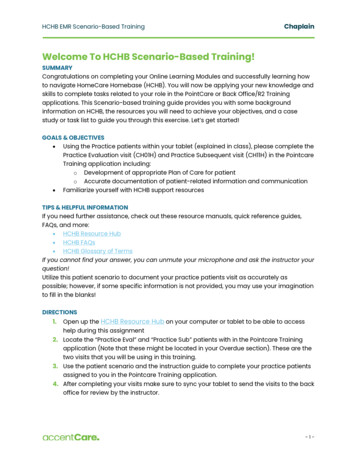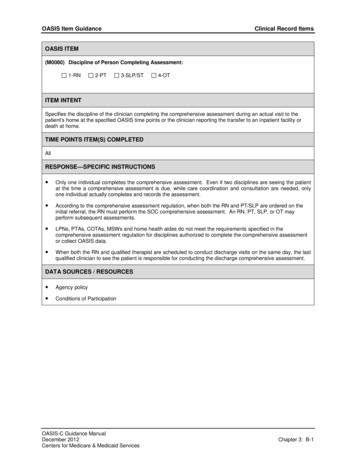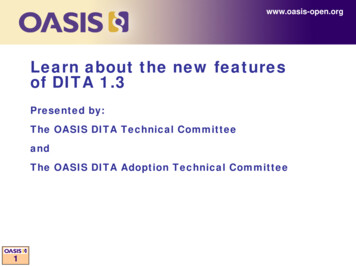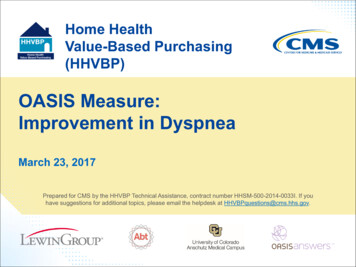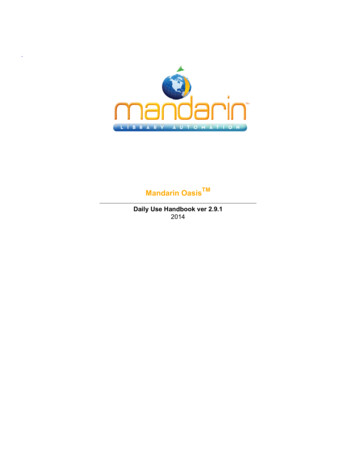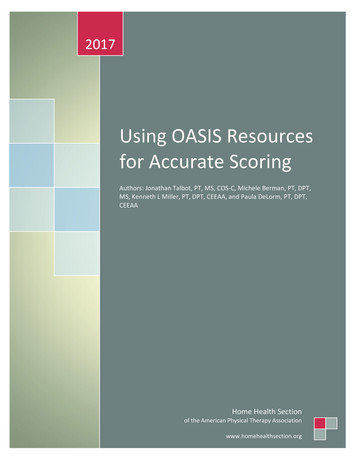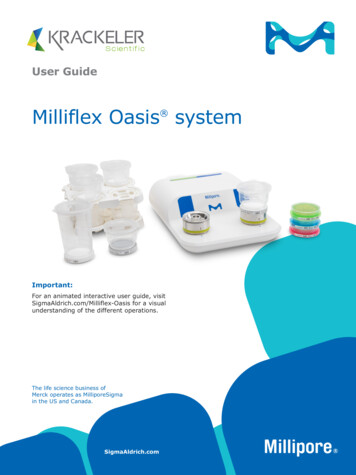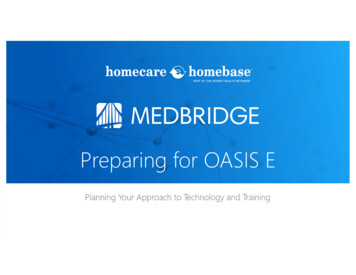
Transcription
Preparing for OASIS EPlanning Your Approach to Technology and Training
EmpoweringExceptionalCare10of the Top 10Home HealthProviders8of the Top 10HospiceProvidersImprove OASIS Accuracyand Boost Quality Ratings
Today’s PresentersCindy Krafft, PT, MS, HCS-OSandy GriffithsOwnerK&K Health Care SolutionsSenior Product ManagerHomecare HomebaseJoseph Brence, PT, DPT, MBA,FAAOMPTHead of Clinical StrategyMedBridge
OASIS E is ComingJanuary 1, 2023
How “New” is OASIS E75% of itemsarethe same25% of itemsarebrand new
27 New OASIS-E Items
New OASIS Items Continued
Current Trends
Chronic Problem AreasFunctional AssessmentCognitive Behavioral IssuesWoundsMedications
Key DefinitionsASSISTANCE Defined as: “help; aid; support” Anything another person would do toensure the safe completion of the task: Physical assistance Verbal Cues Supervision Reminders Ask “Would there be any concerns if noone was there when the task was beingdone?”SAFETY Defined as: “involving little or no risk ofmishap” Impacted by one or more issues: Physical Ability Cognitive Issues Environment Medical Restrictions Sensory Issues Equipment Ask “Am I completely comfortable withhow this task is being completed?”
Function and Fall Risk(M1910) Has this patient had a multi-factor Fall Risk Assessment (such as fallshistory, use of multiple medications, mental impairment, toileting frequency,general mobility/transferring impairment, environmental hazards)0 - No multi-factor falls risk assessment conducted.1 - Yes, and it does not indicate a risk for falls.2 - Yes, and it indicates a risk for falls.
M1850 - Transferring(M1850) Transferring: Current ability to move safely from bed to chair, or ability to turn and position self inbed if patient is bedfast.0 - Able to independently transfer.1 - Able to transfer with minimal human assistance or with use of an assistive device.2 - Able to bear weight and pivot during the transfer process but unable to transfer self.3 - Unable to transfer self and is unable to bear weight or pivot when transferred by another person.4 - Bedfast, unable to transfer but is able to turn and position self in bed.5 - Bedfast, unable to transfer and is unable to turn and position self.
M1342 – Status of Most Problematic(M1342) Status of Most Problematic Surgical Wound that is Observable0 - Newly epithelialized1 - Fully granulating2 - Early/partial granulation3 - Not healing
“Intention” MattersSurgical wounds healing by primary intention do notgranulate, therefore the only appropriate responseswould be 0 – Newly Epithelialized 3 – Not Healing.If the wound is healing solely by primary intention,observe if the incision line has re-epithelialized. If thereis not full epithelial resurfacing such as in the case of ascab adhering to underlying tissue, the correctresponse would be "Not healing" for the woundhealing exclusively by primary intention.Surgical incisions healing by secondary intention dogranulate, therefore may be reported as 0 – Newly epithelialized 1 – Fully Granulating 2 – Early Partial Granulation 3 – Not HealingIf it is determined that there is incisional separation,healing will be by secondary intention
M1700 – Cognitive Functioning(M1700) Cognitive Functioning: Patient's current (day of assessment) level of alertness, orientation, comprehension,concentration, and immediate memory for simple commands.0 - Alert/oriented, able to focus and shift attention, comprehends and recalls task directions independently.1 - Requires prompting (cuing, repetition, reminders) only under stressful or unfamiliar conditions.2 - Requires assistance and some direction in specific situations (e.g., on all tasks involving shifting ofattention), or consistently requires low stimulus environment due to distractibility.3 - Requires considerable assistance in routine situations. Is not alert and oriented or is unable to shiftattention and recall directions more than half the time.4 - Totally dependent due to disturbances such as constant disorientation, coma, persistent vegetative state,or delirium.
M2020 – Management of Oral Medication(M2020) Management of Oral Medications: Patient's current ability to prepare and take all oralmedications reliably and safely, including administration of the correct dosage at the appropriatetimes/intervals. Excludes injectable and IV medications. (NOTE: This refers to ability, not complianceor willingness.)0 - Able to independently take the correct oral medication(s) and proper dosage(s) at thecorrect times.1 - Able to take medication(s) at the correct times if:(a) individual dosages are prepared in advance by another person; OR(b) another person develops a drug diary or chart.2 - Able to take medication(s) at the correct times if given reminders by another person atthe appropriate times3 - Unable to take medication unless administered by another person.NA - No oral medications prescribed.
January 2022 Q&A Consistent theme – medication(s) missing from the home at the time of the assessment Consistent response – “In situations where one or more medications that the patient iscurrently taking and are listed on the Plan of Care are not available to the patient,preventing the patient from being able to demonstrate their ability to manage oral orinjectable medications, the assessing clinician could code using assessment strategiesother than direct observation. The assessing clinician would rely on their assessment ofthe complexity of the patient’s overall drug regimen, as well as patient characteristics,including cognitive status, vision, strength, manual dexterity and general mobility, alongwith any other relevant barriers, and use clinical judgment to determine the patient’scurrent ability. In selecting a code, the clinician may use information gathered by reportand/or observation, including details about when and how the patient accesses andadministers their medications.”WHAT DOES THIS MEAN FOR M2001?
Planning for OASIS E
Standardizing the Review Process A framework is needed to ensure consistency, reduce confusion and provideeducation to the clinicians. The ultimate goal DECREASE ERRORS Critical Areas:– Focus of the review (coding, OASIS, both)– Error identification– Response to errors Coding OASIS
Tracking and TrendingData driven decision making key areas for both errors and corrections: Number Type By Clinician By DisciplineDon’t only focuson the “negative”
What Contributes to Delays?Unclear sLack ofaccountabilityTrue errorsTimelinessClinicianPotential errorsCommunicationReviewer
OASIS EducationCurrent OASISOASIS E ItemsNOWQ4 2022
MedBridge Industry Best Practice for OASIS
Evaluating OASIS Reviewer Trends in HCHBPull the “OASIS Answer Change Trending Report” from HCHB’s Back OfficeReports
Evaluating OASIS Reviewer Trends in HCHBPull the “OASIS Answer Change Trending Report” from HCHB’s Back OfficeReports
Evaluating OASIS Reviewer Trends in HCHBAsk Yourself: Which questions receive the most answer changes?– Why?– Are our reviewers consistent? Which clinicians are struggling with which questions?– What additional training should we provide and to whom? Which clinicians are doing well?– Is there a way we can recognize the clinicians who are doing well?– Is there a way we can encourage the clinicians that are doing well to share their approach with theirpeers?
Referencing CMS Guidance Manuals in PointCareHCHB makes the CMS Guidance Manuals available for reference in PointCare.
Updating Forms for OASIS EHCHB will be releasing OASIS E form templates (22.4 Release – September) BIMS & PHQ2-9 will be scored automaticallyConsiderations when updating forms What order makes the most sense to the clinician filling out the form?– Consider grouping questions by topic– What assessments and non-OASIS questions do I want to continue to utilize?
Patient Outcomes Report
Let’s Continue the ConversationContact MedBridge Kelly Colman, Head of Sales- Home Health, Hospice & Community Care Kelly.colman@medbridgeed.com 425-985-4745Contact Homecare Homebase hchbinfo@hchb.com214-239-6700hchb.comExisting Customers reach out to your Account Executive
Questions & Answers
Senior Product Manager Homecare Homebase Joseph Brence, PT, DPT, MBA, FAAOMPT Head of Clinical Strategy MedBridge. OASIS E is Coming January 1, 2023. How "New" is OASIS E . HCHB makes the CMS Guidance Manuals available for reference in PointCare. Updating Forms for OASIS E HCHB will be releasing OASIS E form templates (22.4 Release .
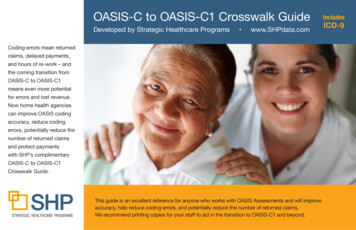
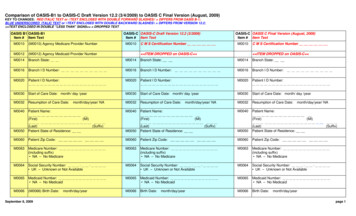

![OASIS-D Handouts [Read-Only] - Missouri](/img/30/oasis-d-powerpoint-2-slides.jpg)
